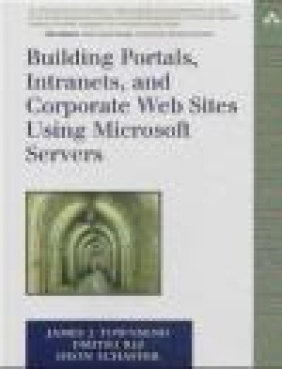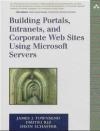Building Portals with Microsoft.NET
Deon Schaffer, James J. Townsend, Dmitri Riz
Building Portals with Microsoft.NET
Deon Schaffer, James J. Townsend, Dmitri Riz
- Producent: Pearson
- Rok produkcji: 2004
- ISBN: 9780321159632
- Ilość stron: 544
- Oprawa: Miękka
Niedostępna
Opis: Building Portals with Microsoft.NET - Deon Schaffer, James J. Townsend, Dmitri Riz
Building Portals, Intranets, and Corporate Web Sites Using Microsoft Servers is the practical guide to designing, developing, and implementing Web portals using Microsoft servers and the .NET Framework. James J. Townsend provides portal development teams with a working developer's overview of the concepts, technologies, and products used in building successful corporate portals. Readers learn how to create a portal architecture based on Microsoft .NET and integrate multiple server technologies and components to create a powerful portal solution. After introducing basic concepts in portal development, Townsend describes the Microsoft portal strategy and the importance of Web services to .NET. Readers become familiar with the .NET portal framework and the roles of Microsoft's SQL Server, Commerce Server (MCS), SharePoint Portal Server, BizTalk Server, Internet Security and Acceleration (ISA) Server, Content Management Server (MCMS), and related technologies. Key topic coverage includes security feature integration, personalization, content management, enterprise application integration (EAI), collaboration features, providing full search capability, and achieving scalability. A companion Web site features all the source code used in examples throughout the book. This book provides practical development advice in answer to questions commonly faced by portal developers, such as: * When does it make sense to develop or deploy a Web service? Page 87 * Is there a straightforward way to mitigate almost all potential security risks? Page 197 * How do you get the most out of personalization? Page 266 * How can you measure the return on investment for content management? Page 269 * Which is the best online conferencing solution for your organization? Page 403 * When and how should you scale up and/or out? Page 446 Building Portals, Intranets, and Corporate Web Sites Using Microsoft Servers shows you how to choose and integrate the right products and build the best portal for your organization.1. Introduction To Portals. Rise of the Portal. Portal Definitions. Types of Portals. Benefits of Portals. Attributes of Portals. Summary. 2. Portal Elements. Look and Feel. Security. User Profile. Personalization. Taxonomy. Application Integration. Database and Other Repositories. Support for Transactions. Collaboration Tools. Multichannel support. Search Engine. Portal Solution Requirements Table. Putting the .NET Portal Together. 3. Microsoft's Portal Strategy. The Microsoft Portal Perspective. Microsoft Office Group. Microsoft Enterprise Software Group. Microsoft Online Properties. Fundamental Portal Elements. Optional Portal Elements. Third Party Portal Elements. Future Evolution of Portal Platform to Juniper and Beyond. Migration of Server Products to .NET. Conclusion: A Two-Pronged Portal Effect. 4. Web Services. Introduction. What Was Life Like Before Web Services? Current Technologies. What Are Web Services? When Does It Make Sense to Develop/Deploy a Web Service? How Do Web Services Fit Into the Portal? Sample Web Service. Web Service Benefits. Conclusion. 5. Portal Framework-.Net. Introduction. The .NET Fundamentals. Building Blocks of the .NET Framework. .NET versus Other Applications. The Portal Architecture. The Portal Framework. Conclusion. 6. Security Services. Common Security Issues. Building Blocks of Secure Application. Authentication and Authorization Flow. IIS Authentication Methods. ASP .NET Authentication Methods. Web Services Authentication. ASP .NET Process Identity. Code Access Security and .NET Framework. Microsoft SQL Server Security. Microsoft Internet Security and Acceleration (ISA) Server 2000. Desigining a Security Strategy. Security Model Changes in Windows Server 2000. Example: Securing an Intranet or Extranet Portal. Summary. 7. User Profiles. Identifying Key User Groups. Registration Methods. Creating User Profiles with Self Registration. Self Registration with Commerce Server 2002. Profile Information. Administering the Profile. Tracking Anonymous Users. Defining SPS Profiles. SharePoint Audiences. SharePoint Single Sign-On. Analyzing Profile and Data. 8. Personalization. The Personalization Cycle. Creating Content for Personalization. Personalizing Homepage Content. Subscriptions, Notifications and Alerts. Advertising Based on Profiles. Getting More Out of Personalization. 9. Content Management. Measuring Return on Investment for Content Management. Content Management Options. Site Framework For Content Management. Content Management Server Overview. Site Framework for Content Management Server. Sharing the Portal Site in MCMS. Creating Templates. Content Creation and Approval Process. Defining Channels. Multilingual Sites. Web Page Workflow Implementation. Enabling Security on MCMS. .NET and Web Services Integration. Content Management in SharePoint. Integrating SharePoint with Microsoft Content Management Server. Custom Content Management. Conclusion. 10. Developing Portal Taxonomy. What Is Taxonomy? Taxonomy Concepts. Sample Taxonomy. Taxonomy Best Practices. Taxonomy Implementation. Ways to Instantiate Taxonomies. Business Value of the Taxonomy. 11. Integrating Line Of Business Applications. Integration Concepts. Providing Intelligent Forms. SharePoint Portal Server and EAI. Integration with Custom Code. BizTalk Concepts. BizTalk Components. Accelerators and Third Party Tools. Benefits of Business Integration. Conclusion. 12. Collaboration In The Enterprise Portal. Collaboration Checklist. The Human Side of Collaboration. SharePoint Version 2 Paradigm. Windows SharePoint Services and SharePoint Portal Server. Creating a Basic Collaboration Site. Creating a Discussion Board. Document Management. Project Teams. Enabling Self-Service Site Creation. Online Conferencing. Understanding Web Parts. Integrating SharePoint Portal Server with Content Management Server. Additional Resources. 13. Search Engine. Introduction. Search Concepts. Microsoft Indexing Service. Managing Search Settings in SharePoint Portal Server. Managing Search Schedules. Managing Search Scopes. Managing Keywords. Scaling Up Your Search Solution. Extending Search. Conclusion. 14. Scalability and the Portal. Planning for Scalability. Scaling Up and Out. Server Operating System. Application Servers. Scaling Up Your Search Solution. Database Repository-SQL Server. ASP .NET Optimization. Performance Testing with the Web Application Center Test. Hosting for Scalability. Additional Scalability Information. Conclusion. Index.
Producent:
GPSR Pearson Central Europe Sp. z o.o.
ul. Szamocka 8
01-748 Warszawa (PL)
tel: 459 596 060
email: [email protected]
Szczegóły: Building Portals with Microsoft.NET - Deon Schaffer, James J. Townsend, Dmitri Riz
Tytuł: Building Portals with Microsoft.NET
Autor: Deon Schaffer, James J. Townsend, Dmitri Riz
Producent: Pearson
ISBN: 9780321159632
Rok produkcji: 2004
Ilość stron: 544
Oprawa: Miękka
Waga: 1 kg





























